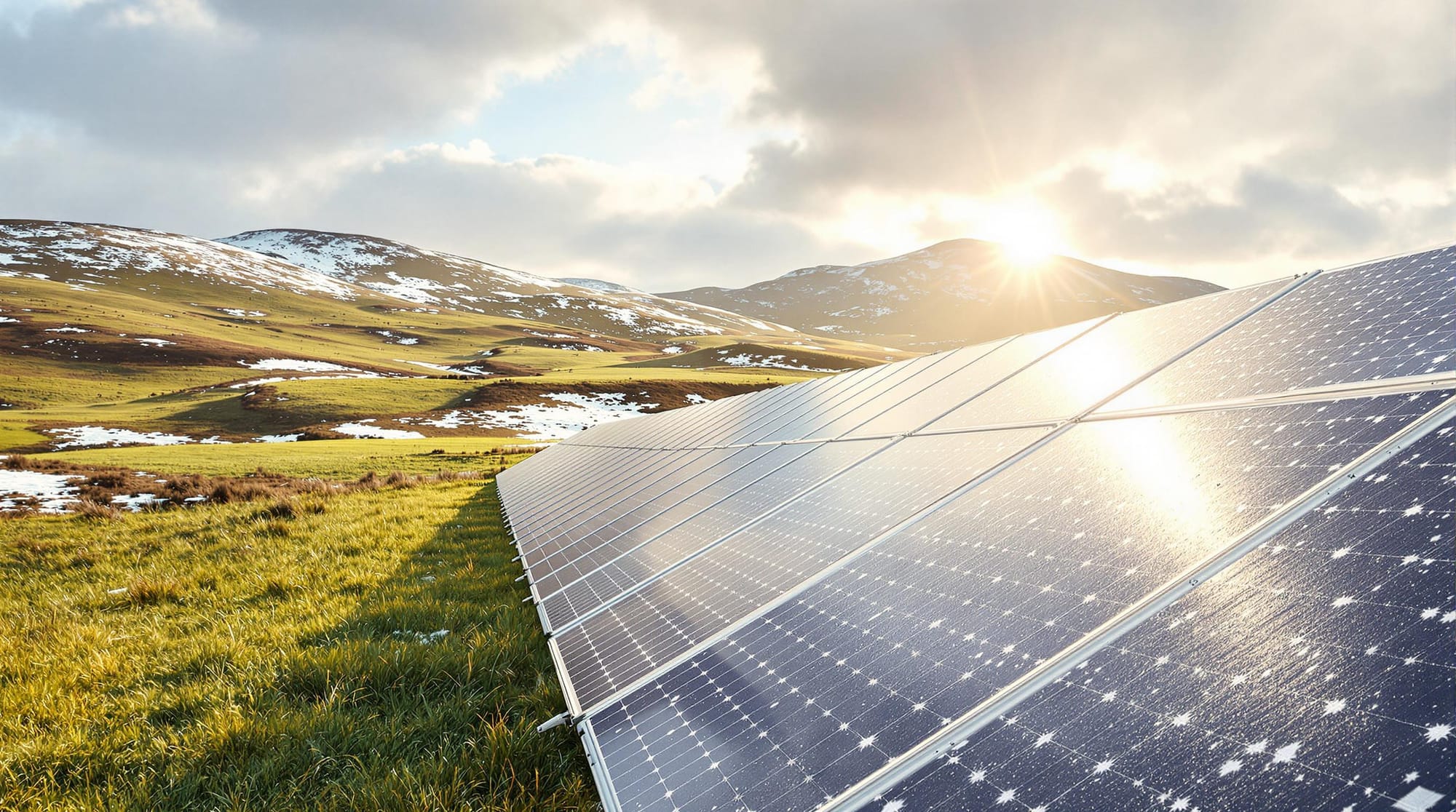Solar Panel Output in Irish Winters
Learn how solar panels can still perform in Irish winters despite challenges like shorter days and low sun angles.

Solar panels can still work effectively in Irish winters, but shorter days, low sun angles, and cloudy weather reduce their energy output. Here’s what you need to know:
- Daylight Hours: Winter days in Ireland have 7-8 hours of light, compared to 16-17 hours in summer, cutting solar production by about 50%.
- Sun Position: The sun’s low angle reduces light intensity by up to 60% and increases shading issues.
- Weather Impact: Cloud cover rises to 85%, and frost or rare snow can block panels temporarily.
- Efficiency Boosts: Cold temperatures improve panel efficiency by 10-15%, but this doesn’t fully offset reduced sunlight.
Quick Tips for Better Winter Performance:
- Adjust Panel Tilt: Steeper angles (40°-45°) capture more winter light.
- Upgrade Panels: Use bifacial panels or advanced low-light models.
- Maintenance: Keep panels clear of debris, frost, and snow with regular checks.
Modern tech like smart inverters and battery storage can help maximize energy even in challenging conditions. With proper planning and upkeep, solar panels can remain a viable energy solution year-round in Ireland.
Solar Panels in Winter - Our Experience
Solar Energy Basics in Ireland
Solar energy use has been expanding rapidly in Ireland. Thanks to advancements in solar technology, energy generation remains possible even during the winter months. Let’s take a closer look at how seasonal changes influence solar output.
How Seasons Affect Solar Output
Seasonal changes in Ireland have a noticeable impact on solar energy production. During winter, there are far fewer daylight hours compared to summer, which naturally lowers energy output. In summer, the sun's direct angle enhances production, while in winter, the sun sits lower on the horizon. This lower angle means sunlight passes through more of the atmosphere, reducing its strength.
Winter Performance Challenges
Seasonal shifts not only affect energy production but also influence the efficiency of solar systems. However, reduced output in winter doesn’t necessarily mean higher costs. Modern systems are designed to perform better in low-light conditions, thanks to technologies like:
- Bifacial panels that capture light from both sides.
- Smart inverters that optimize energy conversion.
- Battery storage to save excess energy for later use.
With thoughtful planning, solar systems can still deliver meaningful savings over the course of a year, even with Ireland's winter challenges. Understanding these dynamics is key to making the most of solar energy, no matter the season.
Main Winter Output Challenges
Winter poses several hurdles for solar panel performance in Ireland, leading to a noticeable drop in energy production during the colder months.
Shorter Days
In December and January, Dublin gets only 7-8 hours of daylight, compared to the 16-17 hours enjoyed during the summer. This means a 50% reduction in sunlight availability. Most energy is generated between 10:00 AM and 2:00 PM, making the window for power production much smaller.
Winter Sun Position
The sun's lower angle during winter adds another layer of difficulty for solar panels in Dublin. In December and January, the sun reaches a maximum elevation of just 14 degrees, compared to 61 degrees in summer. This impacts energy production in several ways:
- Light travels through three times more atmosphere, reducing intensity.
- Light intensity can drop by as much as 60%.
- Shadows from buildings and trees are longer, potentially blocking panels.
- Panels tilted at the standard 30-45 degrees become less effective at capturing sunlight.
Weather Effects
Irish winters bring weather conditions that further hinder solar panel performance:
- Cloud cover increases from 65% during summer to 85% in winter.
- Rainfall averages around 3.7 inches per month in winter.
- Frost in the mornings can reduce efficiency until it clears.
- Snow, though rare, can completely block panels until removed.
Cold Weather: Pros and Cons
While winter weather has its downsides, colder temperatures offer small efficiency gains for solar panels. Here's a breakdown:
| Factor | Benefit | Drawback |
|---|---|---|
| Efficiency | Gains 0.5% per 1.8°F drop below 77°F | Reduced sunlight offsets gains |
| Temperature | Lower heat stress on panels | Frost can block sunlight |
| Durability | Less thermal wear and tear | More frequent cleaning required |
| Storage | Better battery performance | Limited charging cycles |
These cooler temperatures can improve panel conversion rates by 10-15%. However, this boost is often outweighed by the reduced daylight hours and increased cloud cover. Addressing these challenges is key to improving solar output during winter months.
Ways to Improve Winter Performance
Panel Position Tips
To get the most out of your solar panels during winter, adjust their tilt to better capture sunlight. A steeper angle, around 40° to 45°, works better for the lower winter sun compared to flatter angles. Make sure the panels face true south and remove anything blocking sunlight, like overhanging branches or nearby structures.
Upgraded Panel Choices
Today's solar panels are designed to handle low-light conditions more effectively. For instance, bifacial panels can generate extra energy by using light reflected off surfaces like snow or frost. Advanced cell technologies also improve performance in dim conditions. While these panels may come with a higher price tag, they can provide better energy output during darker months.
Winter Care Steps
Regular upkeep is key to keeping your solar system running smoothly through winter. Here’s a simple maintenance plan:
- Weekly checks: Look for snow, frost, or debris that might block sunlight.
- Monthly system monitoring: Keep an eye on energy output to spot any issues early.
- Professional inspections: Schedule periodic checks to ensure wiring and connections are secure.
When clearing snow, use a soft brush with a long handle to avoid scratching the panels. Stay away from hot water or metal tools, as these can cause damage. Also, keep gutters clear to prevent ice dams that could affect your system’s stability. Protecting inverters with basic shelters can help them withstand winter storms and stay efficient.
Professional Help and Resources
While routine checks are essential, some winter-related solar issues demand professional attention. Regular upkeep can maintain efficiency, but problems like underperformance, wiring damage, or weather-related wear often require expert diagnosis and repair.
When selecting a solar professional, consider the following:
- Certification: Ensure they are SEAI-certified.
- Winter expertise: Ask about their experience with cold-weather solar challenges.
- Insurance: Confirm they have liability insurance for winter-related work.
- Emergency services: Check if they provide 24/7 support during winter storms.
For more advanced winter solutions, professional services can make a big difference.
Get Solar Panels
Services like Get Solar Panels specialize in addressing Ireland's unique winter conditions. They provide:
- System assessments to pinpoint winter performance issues.
- Tesla Powerwall integration for reliable energy storage during colder months.
- The latest in solar technology, such as perovskite solar cells for improved low-light efficiency.
- Guidance on government grants and zero-VAT installation options.
Their platform also offers detailed advice on maintaining solar efficiency during Irish winters, including:
| Winter Service | Description | Benefit |
|---|---|---|
| Performance Audit | Full system evaluation | Detects efficiency issues before winter |
| Weather Protection | Protective installations | Shields against storms and frost damage |
| Storage Solutions | Tesla Powerwall integration | Provides reliable power during low light |
| Monitoring Setup | Advanced tracking systems | Quick action on winter-related problems |
Professional inspections and tailored solutions can help safeguard your solar investment through the toughest winter conditions.
Conclusion
Solar panels continue to work effectively during Irish winters, even though energy output naturally decreases. By employing smart strategies, you can maintain solid performance throughout the colder months.
Developments like better panel coatings, advanced monitoring systems, and bifacial panel designs help boost efficiency. For instance, bifacial panels can take advantage of light reflected off snow, increasing energy production. These advancements play a big role in creating systems that perform well year-round.
Regular maintenance is essential to keep solar systems running smoothly in winter. Companies like Get Solar Panels offer services such as winter assessments, Tesla Powerwall integration, and are exploring cutting-edge technologies like perovskite solar cells to improve performance in low-light conditions.
To ensure reliable winter energy production, focus on proper panel placement, consistent maintenance, and efficient energy storage. As highlighted earlier, a well-thought-out system and proactive care make all the difference.
Looking forward, solar energy in Ireland is becoming a more dependable option for homes and businesses year-round, thanks to ongoing technological progress that minimizes seasonal challenges.

